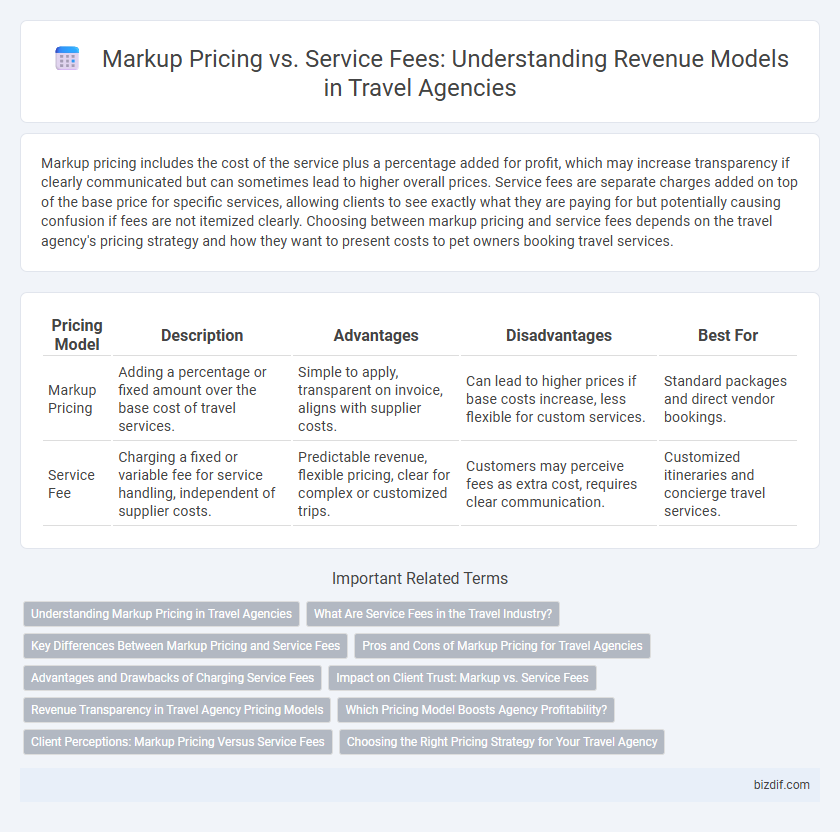Markup pricing includes the cost of the service plus a percentage added for profit, which may increase transparency if clearly communicated but can sometimes lead to higher overall prices. Service fees are separate charges added on top of the base price for specific services, allowing clients to see exactly what they are paying for but potentially causing confusion if fees are not itemized clearly. Choosing between markup pricing and service fees depends on the travel agency's pricing strategy and how they want to present costs to pet owners booking travel services.
Table of Comparison
| Pricing Model | Description | Advantages | Disadvantages | Best For |
|---|---|---|---|---|
| Markup Pricing | Adding a percentage or fixed amount over the base cost of travel services. | Simple to apply, transparent on invoice, aligns with supplier costs. | Can lead to higher prices if base costs increase, less flexible for custom services. | Standard packages and direct vendor bookings. |
| Service Fee | Charging a fixed or variable fee for service handling, independent of supplier costs. | Predictable revenue, flexible pricing, clear for complex or customized trips. | Customers may perceive fees as extra cost, requires clear communication. | Customized itineraries and concierge travel services. |
Understanding Markup Pricing in Travel Agencies
Markup pricing in travel agencies involves adding a fixed percentage or flat amount to the wholesale cost of travel services, allowing agencies to cover operational expenses while generating profit. This method ensures transparent pricing by including costs such as supplier fees, commissions, and agency overhead within the final price shown to customers. Understanding the distinction between markup pricing and service fees helps travelers recognize how agencies balance competitive pricing with quality service delivery.
What Are Service Fees in the Travel Industry?
Service fees in the travel industry are fixed charges imposed by agencies to cover operational costs such as booking assistance, itinerary customization, and customer support. Unlike markup pricing, which increases the base price of travel products, service fees are transparent and separate, ensuring clients understand the exact cost of services provided. These fees help travel agencies maintain quality service while offering competitive prices on flights, hotels, and vacation packages.
Key Differences Between Markup Pricing and Service Fees
Markup pricing involves adding a percentage or fixed amount to the base cost of travel products, directly increasing the price paid by customers. Service fees are separate charges applied for booking or consultation services, distinct from the actual product cost. The key difference is that markup affects the product price itself, while service fees cover operational or customer support expenses without altering base prices.
Pros and Cons of Markup Pricing for Travel Agencies
Markup pricing in travel agencies involves adding a percentage to the base cost of travel services, which simplifies pricing but may reduce transparency for clients. This method allows agencies to cover operational costs easily and maintain profit margins, yet it can lead to higher prices compared to competitors who use service fees. However, markup pricing risks client distrust if fees appear inflated and limits flexibility in customizing service charges.
Advantages and Drawbacks of Charging Service Fees
Charging service fees in travel agencies ensures transparent pricing, allowing clients to understand the exact cost of expertise and personalized services without hidden markups. This approach fosters trust and can enhance customer satisfaction but may deter price-sensitive travelers who compare total costs across providers. However, service fees provide consistent revenue streams, benefiting agency profitability even when supplier prices fluctuate.
Impact on Client Trust: Markup vs. Service Fees
Markup pricing often decreases client trust as travelers may feel hidden costs inflate the final price, leading to suspicion about the agency's transparency. Service fees, when clearly communicated, enhance trust by providing straightforward charges for specific services without altering base prices. Transparent service fees align with client expectations, fostering long-term loyalty and positive reviews for travel agencies.
Revenue Transparency in Travel Agency Pricing Models
Markup pricing in travel agencies involves embedding the agency's profit margin directly into the base cost of travel products, which can obscure the actual price and reduce revenue transparency for customers. Service fees, on the other hand, separate the agency's charges from the product cost, clearly itemizing fees to enhance transparency and build trust. Transparent pricing models that distinguish between base costs and service fees enable travelers to better understand what they are paying for, improving satisfaction and potentially increasing bookings.
Which Pricing Model Boosts Agency Profitability?
Markup pricing allows travel agencies to add a percentage to the wholesale cost of travel products, directly increasing revenue per sale while maintaining transparent client pricing. Service fees generate consistent income by charging fixed amounts for booking or consultation services, reducing reliance on supplier price fluctuations and improving cash flow predictability. Agencies adopting a hybrid model that balances markup pricing with strategic service fees often achieve higher profitability by optimizing revenue streams and managing operational costs effectively.
Client Perceptions: Markup Pricing Versus Service Fees
Clients often perceive markup pricing as a less transparent method since the increased cost is embedded directly into the travel package, making it harder to identify additional charges. Service fees, on the other hand, are viewed as more straightforward because they are itemized separately, allowing clients to understand exactly what they are paying for specific services. Transparency in pricing significantly influences client trust and satisfaction in choosing between markup pricing and service fees.
Choosing the Right Pricing Strategy for Your Travel Agency
Markup pricing involves adding a fixed percentage to the cost of travel services, directly influencing profit margins and customer pricing transparency. Service fees are flat or variable charges applied for specific services, offering flexibility and clear separation of costs from base prices. Selecting the right strategy requires analyzing market competition, customer preferences, and operational costs to maximize revenue while maintaining client trust and satisfaction.
Markup pricing vs Service fee Infographic

 bizdif.com
bizdif.com